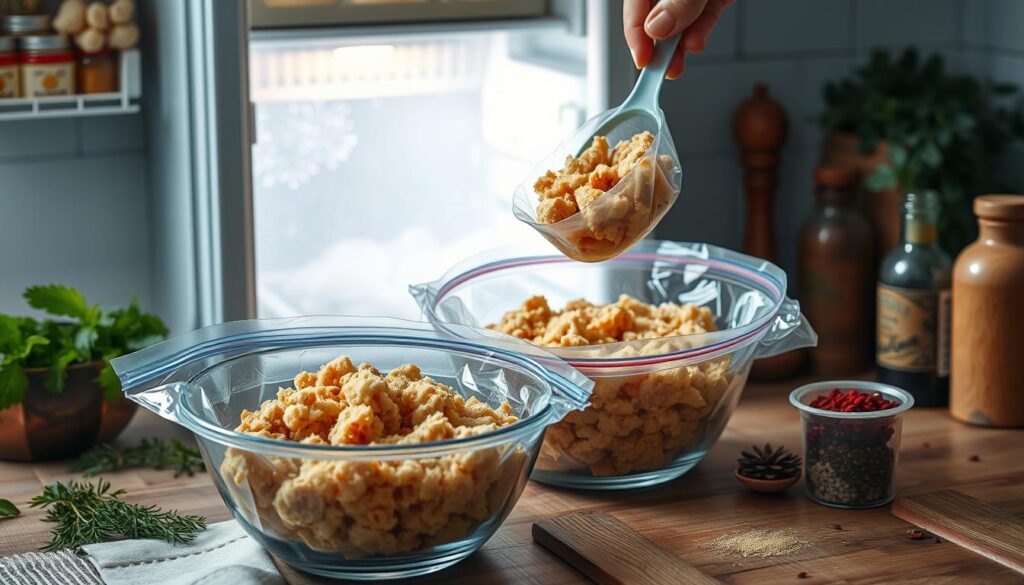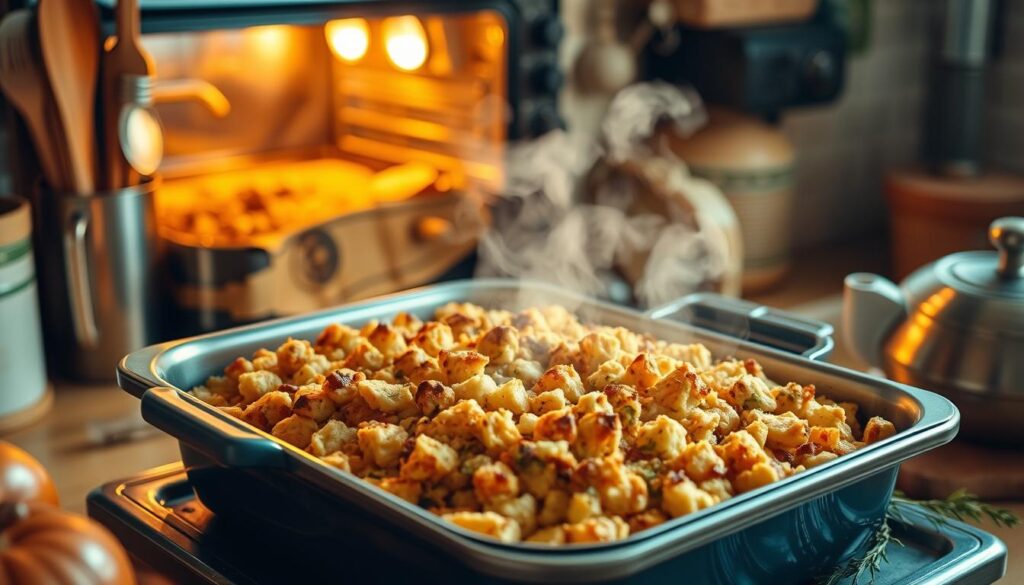The holiday season is a time to gather with loved ones and enjoy delicious feasts. But what do you do with leftover stuffing after the holidays? Freezing it can be a lifesaver, letting you enjoy those comforting flavors for weeks.
I love the holiday season and preserving leftovers. Imagine enjoying a warm, comforting meal on a cold winter day. The smell of reheated stuffing brings back the joy of the holidays. Properly stored and frozen stuffing is a gift that keeps on giving.
Key Takeaways
- Freezing leftover stuffing is a great way to preserve holiday flavors
- Proper storage and preparation techniques are essential for successful freezing
- Knowing the maximum freezer storage time and safe thawing methods is crucial
- Identifying signs of spoilage can help ensure the quality and safety of frozen stuffing
- Reheating frozen stuffing can be done in multiple ways to maintain its delicious taste and texture
Understanding Stuffing Storage Basics
Knowing how to store leftover stuffing is key. This includes the types that freeze well and the best storage conditions. These tips help keep your stuffing fresh and safe to eat.
Types of Stuffing Suitable for Freezing
Not all stuffing is good for freezing. Bread-based stuffings like cornbread or herb-seasoned cubes freeze well. But wild rice or oyster stuffing might not be as good. Choose a stuffing that keeps its texture and taste after freezing and thawing.
Food Safety Considerations
Food safety is crucial when storing cooked stuffing. Cool it down and refrigerate it quickly to stop bacteria growth. Keeping it at a temperature below 40°F helps it last longer and stay good.
Optimal Storage Conditions
- Airtight containers or freezer bags to prevent freezer burn
- Consistent freezer temperature, ideally 0°F or below
- Proper labeling with the date of freezing for tracking the stuffing’s shelf life
By following these storage tips, your leftover stuffing will stay tasty and safe. Good storage helps your stuffing last longer, making your holiday meal even better.
Can You Freeze Leftover Stuffing?
Yes, you can freeze leftover stuffing. It’s a great way to save time and reduce waste, especially after Thanksgiving. You can keep your turkey or vegetarian stuffing for later with a few easy steps.
Most stuffing types, like bread or cornbread, freeze well. This means you can enjoy homemade stuffing months after Thanksgiving. It keeps its taste and texture.
But, you must follow food safety rules when freezing stuffing. Proper packaging and storage are crucial. This way, your stuffing stays fresh and safe to eat. With some prep, you can freeze leftover stuffing and enjoy Thanksgiving flavors all year.

Frozen stuffing can be reheated in many ways. You can use the oven or microwave. This makes it a tasty and easy option for meals or sides. So, don’t throw away those leftovers. Use the power of freezing leftover stuffing to enjoy Thanksgiving tastes all year.
Preparing Stuffing for Freezer Storage
Storing leftover stuffing is a smart way to cut down on food waste. It lets you enjoy your favorite dishes even after the holiday. To keep your stuffing fresh and safe, follow a few easy steps.
Cooling Process
First, let the stuffing cool down completely. This step stops bacteria growth and keeps the stuffing’s texture right when you reheat it. Cool it to room temperature, then chill it in the fridge for at least 2 hours before freezing.
Portioning Guidelines
- Split the leftover stuffing into portions for one or your whole family. This makes reheating easier.
- Go for portions of 1-2 cups. This size is great for reheating in many ways.
- Don’t pack the stuffing too tightly. This can mess up its texture and make it hard to thaw evenly.
Proper Packaging Materials
After portioning, pick the right packaging. Use airtight containers like heavy-duty freezer bags or strong plastic containers. These keep air out and prevent freezer burn, which can ruin the stuffing’s taste and texture.
When you package the stuffing, squeeze out as much air as you can. This creates a tight seal and keeps the stuffing safe from the freezer. Vacuum sealing is the best choice, as it removes all air and makes a compact, secure package.
Step-by-Step Guide to Freezing Stuffing
Freezing leftover stuffing is a smart way to enjoy it later. Follow this guide to freeze your freezing stuffing successfully. It will also meet your leftover side dish storage needs.
First, let the stuffing cool down completely before freezing. This step is key to avoid bacteria and keep food safe. After cooling, divide the stuffing into portions. Use airtight containers or freezer-safe bags for this.
- Make sure to label the containers or bags with the date and what’s inside.
- Remove as much air as you can before sealing to avoid freezer burn.
- For extra safety, wrap the packages in aluminum foil or put them in a bigger freezer bag.
To enjoy your frozen stuffing, thaw it in the fridge overnight. Then, reheat it in the oven, on the stovetop, or in the microwave. Make sure it’s hot and well-heated.
“Properly freezing and storing your leftover stuffing can extend its shelf life and ensure you can enjoy it for weeks to come.”
By following these easy steps, you can freeze stuffing and have a tasty leftover side dish storage option for future meals. Enjoy your homemade stuffing all year!

Best Containers and Wrapping Methods
Choosing the right containers and wrapping methods is key for storing cooked stuffing or freezing Thanksgiving leftovers. The right choice can keep your food fresh and tasty. Let’s look at some top options to keep your stuffing delicious after freezing.
Airtight Container Options
Airtight containers are perfect for freezing stuffing. They seal tightly to keep air out and prevent freezer burn. Use high-quality plastic or glass containers with tight lids. Make sure the containers are without cracks or damage to keep the seal tight and prevent spoilage.
Freezer Bag Techniques
Freezer bags are also a good choice for storing cooked stuffing or freezing Thanksgiving leftovers. Choose heavy-duty, freezer-safe bags that can handle the cold and keep air out. Remove as much air as you can before sealing to keep your food fresh longer.
Vacuum Sealing Benefits
Vacuum sealing is the best way to keep your food air-tight. This method removes all air from the packaging, creating a safe space for your frozen stuffing. Vacuum sealing can make your leftovers last up to 2-3 times longer than other methods.
Whichever container or wrapping method you pick, make sure to label it with the date and use-by info. This way, you can enjoy your Thanksgiving feast’s flavors for weeks.
Maximum Freezer Storage Time for Stuffing
Knowing the stuffing shelf life and leftover stuffing storage is key. Proper freezer storage keeps your stuffing fresh for weeks. This is true for both homemade and store-bought stuffing.
Stuffing can safely stay in the freezer for 3 to 4 months. This rule applies to both cooked and uncooked stuffing. But, the exact shelf life depends on the ingredients and how it’s made.
- Bread-based stuffing usually lasts about 3 months in the freezer.
- Cornbread or rice-based stuffing can last up to 4 months.
- Stuffing with meat, like sausage or oysters, should be eaten within 3 months for best taste and safety.
When freezing leftover stuffing, label each container or bag with the freezing date. This helps you keep track of the stuffing shelf life. It also ensures you use the oldest items first. Organizing your frozen stuffing by date and type makes it easier to find and use.
Using airtight containers or vacuum sealing can help your stuffing last longer in the freezer. By following these tips, you can enjoy your stuffing for a long time. This way, you don’t have to worry about losing taste or compromising food safety.
How to Thaw Frozen Stuffing Safely
If you’ve made a tasty batch of stuffing and have leftovers, you’ll need to thaw them safely. There are easy ways to defrost your stuffing without losing its flavor or texture.
Refrigerator Method
The best way to thaw stuffing is in the fridge. This slow thaw keeps the stuffing’s taste and texture. Just put the frozen stuffing in the fridge and let it thaw for 24 to 48 hours, depending on its size.
Microwave Defrosting Tips
For a quicker thaw, use the microwave. Set it to defrost and heat the stuffing in 1-minute bursts, stirring often. This way, you avoid drying out the stuffing.
Direct Cooking Options
For the quickest thaw, cook the frozen stuffing straight from the freezer. Preheat your oven to 350°F (175°C). Put the stuffing in a dish and cover it with foil. Bake for 45 to 60 minutes, until it’s hot and the inside is 165°F (74°C).
Choose any thawing method, but always follow food safety rules. This way, your leftover stuffing will be safe and delicious to eat.
Reheating Methods for Frozen Stuffing
Whether you’ve made a big batch of stuffing for a holiday or have leftovers, knowing how to reheat it is important. You can use the oven, stovetop, or microwave to reheat your stuffing. Each method has its own benefits for keeping the stuffing tasty and moist.
Oven Reheating Technique
The oven is the best way to reheat stuffing evenly. Preheat it to 350°F (175°C). Put the frozen stuffing in an oven-safe dish, cover it with foil, and heat for 20-30 minutes. Stir it halfway through to make sure it’s hot all the way.
Stovetop Reheating Approach
If you’re in a hurry, the stovetop can be a good choice. Put the frozen stuffing in a saucepan or skillet over medium heat. Stir often and add broth or water to stop it from sticking. Heat it until it’s hot, about 10-15 minutes.
Microwave Reheating Tips
The microwave is quick but might not heat evenly. Put the stuffing in a microwave-safe dish, cover it loosely, and heat in 1-minute bursts. Stir between each heating until it’s hot, about 3-5 minutes. Watch it closely to avoid drying out the edges.
Choose the method that works best for you, but always check the stuffing often. Adjust the time as needed to get it just right. This way, you can enjoy your leftover stuffing whenever you want.

Signs of Spoiled Stuffing to Watch For
Properly storing cooked stuffing is key to keeping it fresh and safe. But, it’s also important to watch for signs that it might have spoiled. Knowing how to spot spoiled stuffing can help prevent foodborne illnesses in your family.
Visual Indicators
One of the first signs of spoiled stuffing is a change in its look. Look for any dark spots or mold. Bad stuffing might also look slimy or watery.
Texture Changes
Changes in texture can also indicate spoiled stuffing. If it’s mushy, crumbly, or hard, it’s gone bad. Properly stored stuffing should stay firm and cohesive.
Odor Warning Signs
A bad smell is a clear sign of spoiled stuffing. Fresh stuffing smells savory and appetizing. But, spoiled stuffing smells sour, rancid, or like ammonia. If it smells off, don’t take a chance.
Watching for visual, textural, and smell changes helps you address any storing cooked stuffing or stuffing shelf life issues quickly. Regular checks can keep your family safe from spoiled food.
Conclusion
In conclusion, we’ve looked into freezing leftover stuffing and how to do it right. It’s clear that can you freeze leftover stuffing and keep it fresh for later. This way, you can enjoy your holiday meals again and again.
Important points include knowing which stuffing is good for freezing and following food safety rules. Also, there’s a step-by-step guide on how to prepare, package, and store it. Using airtight containers, freezer bags, or vacuum sealing helps keep your leftover stuffing storage fresh and tasty.
Finally, this article has given you the confidence to freeze stuffing and enjoy your holiday meals more. It helps reduce food waste and keeps your stuffing delicious for longer. Now, you can enjoy your stuffing’s flavors even after the holidays are over.
FAQ
Can I freeze leftover stuffing?
Yes, you can freeze leftover stuffing. This way, you can keep its flavor and texture for later.
What types of stuffing can be frozen?
You can freeze most stuffing types, like bread-based, cornbread, and wild rice. But, stuffing with lots of moisture, like fresh herbs or fruits, might not freeze as well.
How long can frozen stuffing be stored?
Frozen stuffing can last 3-4 months if stored right. Make sure to label the containers with the date.
How do I prepare stuffing for freezing?
Cool the stuffing completely before putting it in airtight containers or freezer bags. Don’t fill the containers too much to allow for expansion.
What’s the best way to thaw frozen stuffing?
Thawing in the fridge is best, taking 24-48 hours. You can also thaw it in the microwave or cook it straight from frozen.
How do I reheat frozen stuffing?
To reheat, put the stuffing in an oven-safe dish and bake at 350°F for 30-45 minutes. You can also reheat it on the stovetop or in the microwave, stirring often.
How do I know if my frozen stuffing has gone bad?
Bad stuffing smells sour or off, has mold, or looks slimy or discolored. If it doesn’t smell or look right, throw it away.

